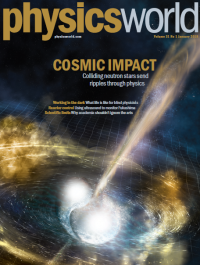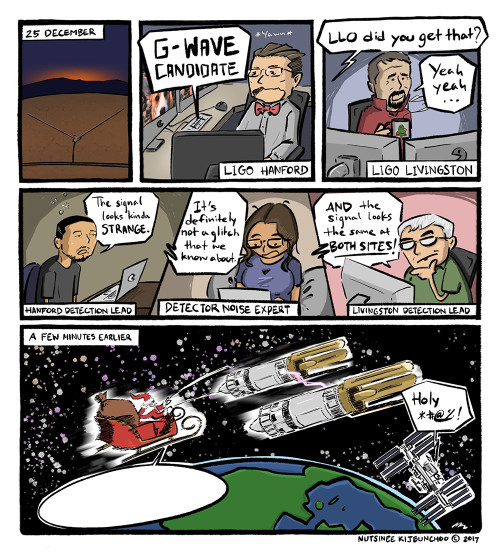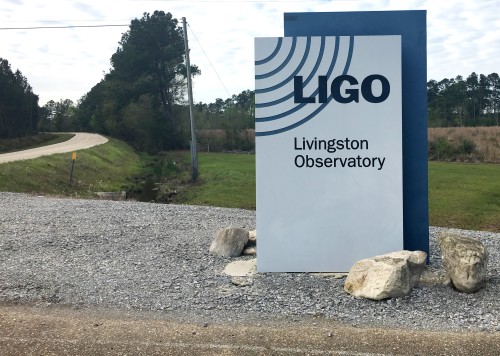Tag archives: gravitational waves
See in the new year with the January 2018 issue of Physics World
Happy new year and welcome back to Physics World after our winter break. Why not get 2018 off to a great start with the January 2018 issue of Physics World, which is now out in print and digital format.
In our fantastic cover feature this month, Imre Bartos from Columbia University in New York examines the massive impact on physics that last year’s spectacular observation of colliding neutron stars will have.
Elsewhere, Bruce Drinkwater from the University of Bristol explains how he is using ultrasonics to monitor the damaged Fukushima nuclear-power plant in Japan, while science writer Jon Cartwright looks at how technology can help blind physicists.
Don’t miss either our interview with Fermilab boss Nigel Lockyer and do check out our tips for how to brush up your CV if you’re chasing a job in industry.
View all posts by this author | View this author's profile
A very LIGO Christmas
By Tushna Commissariat
Every December, we like to do something special for you, dear readers, as the year draws to an end. As you are undoubtedly aware, some of the most exciting news in physics this year came from the world of gravitational-wave research and multimessenger astronomy, in the first ever observation of a neutron-star merger. Indeed, this global discovery bagged our 2017 Breakthrough of the Year award, while the pioneers of gravitational-wave astronomy won this year’s Nobel prize in physics.
View all posts by this author | View this author's profile
Riding around KAGRA

Tunnel vision: entry point to the KAGRA gravitational-wave observatory in Kamioka. (Courtesy: Michael Banks)
By Michael Banks in Kamioka, Japan
Of all the places I have been, I can’t remember being asked to ride a bicycle for 3 km down a dimly lit tunnel that had water dripping – sometimes pouring – from the ceiling.
But that’s what happened today when I visited the KAGRA gravitational-wave observatory in northern Japan.
Rising bright and early – a common occurrence this week thanks to jet lag – I took the Shinkansen from Tokyo to Toyama.
View all posts by this author | View this author's profile
What gravitational waves did (and didn’t) tell us about GW17081
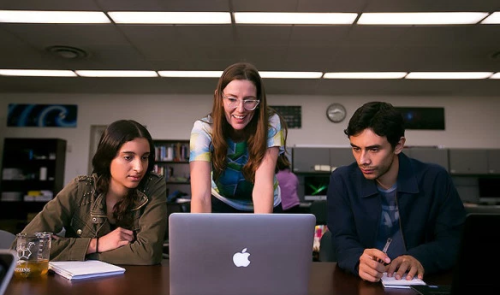
Rotating into view: Jocelyn Read (centre) and undergraduate students Isabella Molina (left) and Erick Leon. (Courtesy: CQG+)
By Hamish Johnston
The GW170817 neutron-star merger was by no means an instantaneous event. Physicists working on the LIGO-Virgo gravitational-wave detectors were able to watch the two stars spiral towards each other for about 100 s before they merged. Valuable information about the neutron stars has been gleaned from the observation, but the detectors were unable to see the merger itself and its aftermath.
In “The gravitational-wave story of a neutron-star merger”, Jocelyn Read of California State University Fullerton takes up the story at 17 min before the merger. Then, the neutron stars would have been be separated by about 700 km and have an orbital frequency of about 10 Hz.
View all posts by this author | View this author's profile
Neutron star merger as it happened
By Hamish Johnston
At 12:41:20 UTC on 17 August, the Fermi Gamma-ray Space Telescope sent a notice to the astronomy community saying that it had detected a gamma-ray burst. Normally such an event wouldn’t raise much fuss – but this time things would be very different.
Back on Earth, scientists working on the LIGO-Virgo gravitational wave detectors were busy analysing a signal that had arrived about 2 s before the gamma-ray burst and looked very much like the merger of two neutron stars. Such a cataclysmic event is expected to give off copious amounts of electromagnetic radiation including an initial burst of gamma rays.
View all posts by this author | View this author's profile
New cosmic messengers, and what they can tell us
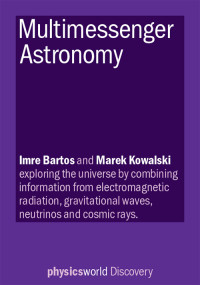 By Margaret Harris
By Margaret Harris
Immediately after last year’s announcement that the Laser Interferometer Gravitational-Wave Observatory (LIGO) had seen its first gravitational waves, a lot of the discussion centred on what the discovery meant for general relativity. This was understandable: getting further confirmation of Einstein’s century-old theory was (and is) a big deal. But in the longer term, and as the LIGO detectors notch up a few more observations (they’re currently crunching data on six new candidates), the emphasis will shift away from the waves themselves, and towards what they can tell us about the universe.
The key thing to realize here is that gravitational waves are fundamentally different from other, better-studied cosmic “messengers” that travel to Earth from distant reaches of the universe. Unlike photons, gravitational waves are not impeded by clouds of gas or dust; unlike cosmic rays, they are not deflected by electromagnetic fields. In addition, some of the most dramatic astrophysical events, such as the merger of two black holes in empty space, are “dark” or “silent” to other messengers: these events produce gravitational waves in copious quantities, but not, as far as we know, anything else.
View all posts by this author | View this author's profile
How LIGO got the word out about gravitational waves
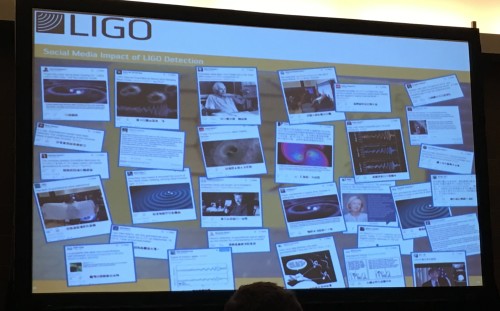
Tweeting to millions: LIGO made a social-media plan before announcing the detection. (Courtesy: Sarah Tesh)
By Sarah Tesh
Nowadays, social media plays a big role in communicating science to the public. It has two important qualities – it’s free and it’s international. A great case study for social media and science came last year when the Laser Interferometer Gravitational-Wave Observatory (LIGO) announced the first ever detection of gravitational waves. To tell us more about how the team grabbed the public’s attention (and got its work on Sheldon Cooper’s T-shirt in The Big Bang Theory), LIGO scientist Amber Stuver gave a witty talk at the APS March Meeting 2017 about the outreach strategy.
She began by telling us the story of that exciting detection day. Before the first detection, LIGO had published 80 papers on “detecting nothing”. Yet on 14 September 2015 – the first morning of the first day of Advanced LIGO – the much-sought-after signal appeared. The first thing that had to be done was to check it wasn’t a fake. Having detected nothing for so long, those with the knowledge to do so would sometimes “inject” results to check the system worked and keep the scientists on their toes.
View all posts by this author | View this author's profile
Physics World visits LIGO Livingston
By Tushna Commissariat and Sarah Tesh at LIGO Livingston, Louisiana, US
Being a journalist can be a busy and often stressful job, especially as deadlines loom fast and furious. But one of the best perks of the job is the chance to meet some amazing people and visit some of the best scientific facilities in the world. As most regualr readers of Physics World will know, we – Sarah and Tushna – have been in New Orleans, Lousiana for the APS March Meeting 2017. And it just so happens that about a two-hour drive away from New Orleans lies one half of one of the most advanced experiments in the world – the Laser Interferometer Gravitational-wave Observatory (LIGO) at Livingston.
View all posts by this author | View this author's profile
Waking up to a gravitational wave
By Hamish Johnston
Yesterday we announced the winner of the Physics World 2016 Breakthrough of the Year, which went to the LIGO Scientific Collaboration for its revolutionary, first ever direct observations of gravitational waves. I caught up with six LIGO scientists in the above video Hangout and asked them what it was like when they first realized that they had detected gravitational waves emanating from two coalescing black holes 1.3 billion light-years away.
View all posts by this author | View this author's profile
Chasing gravitational waves in song, physicists on Broadway, the ‘impossible space engine’ returns
By Hamish Johnston
These days anyone making a major breakthrough in physics is expected to follow-up with a cheesy music video. So give it up for The Mavericks and “Chasing the Waves”, which chronicles the quest to detect gravitational waves – which culminated in LIGO’s success earlier this year. I don’t much about this video, but it seems to have been filmed at the University of Glasgow, which is part of the LIGO collaboration.
View all posts by this author | View this author's profile
